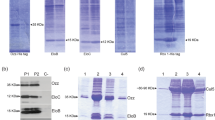Abstract
As the role for adaptor proteins constantly proliferates, appreciation of their importance has never been higher. The Crk family of adaptor proteins is no exception. Currently comprising four members, v-Crk, CrkI, CrkII and Crk-like protein, we have introduced a fifth member, CrkIII. Cloned by the CORT technique, CrkIII is identical in sequence to CrkII until the second of its two SH3 domains, which is disrupted partway through and results in a nonfunctional domain and a unique C-terminal sequence. We have demonstrated the existence of native CrkIII at the message level using RT–PCR and RNAse protection assays, and at the protein level in mouse fibroblasts. We show that CrkII overexpression is capable of enhancing insulin-stimulated ERK activity, whereas CrkIII is not, thus partially characterizing a novel member of the Crk family and elucidating important effects mediated by the c-terminal SH3 domain.
This is a preview of subscription content, access via your institution
Access options
Subscribe to this journal
Receive 50 print issues and online access
$259.00 per year
only $5.18 per issue
Buy this article
- Purchase on Springer Link
- Instant access to full article PDF
Prices may be subject to local taxes which are calculated during checkout






Similar content being viewed by others
References
Akagi T, Shishido T, Murata K and Hanafusa H . (2000). Proc. Natl. Acad. Sci. USA, 97, 7290–7295.
Beitner-Johnson D, Blakesley VA, Shen-Orr Z, Jimenez M, Stannard B, Wang LM, Pierce J and LeRoith D . (1996). J. Biol. Chem., 271, 9287–9290.
Birge RB, Fajardo JE, Reichman C, Shoelson SE, Songyang Z, Cantley LC and Hanafusa H . (1993). Mol. Cell. Biol., 13, 4648–4656.
Feller SM . (2001). Oncogene, 20, 6348–6371.
Feng S, Chen JK, Yu H, Simon JA and Schreiber SL . (1994). Science, 266, 1241–1247.
Foschi M, Chari S, Dunn MJ and Sorokin A . (1997). EMBO J., 16, 6439–6451.
Fukazawa J, Miyake S, Band V and Band H . (1996). J. Biol. Chem., 271, 14554–14559.
Fukui Y, Kornbluth S, Jong SM, Wang LH and Hanafusa H . (1989). Oncogene Res., 4, 283–292.
Knudsen BS, Feller SM and Hanafusa H . (1994). J. Biol. Chem., 269, 32781–32787.
Lowenstein EJ, Daly RJ, Batzer AG, Li W, Margolis B, Lammers R, Ullrich A, Skolnik EY, Bar-Sagi D and Schlessinger J . (1992). Cell, 70, 431–442.
Margolis B, Silvennoinen O, Comoglio F, Roonprapunt C, Skolnik E, Ullrich A and Schlessinger J . (1992). Proc. Natl. Acad. Sci. USA, 89, 8894–8898.
Matsuda M, Hashimoto Y, Muroya K, Hasegawa H, Kurata T, Tanaka S, Nakamura S and Hattori S . (1994). Mol. Cell. Biol., 14, 5495–5500.
Matsuda M, Tanaka S, Nagata S, Kojima A, Kurata T and Shibuya M . (1992). Mol. Cell. Biol., 12, 3482–3489.
Mayer BJ, Hamaguchi M and Hanafusa H . (1988). Nature, 332, 272–275.
Okada S, Matsuda M, Anafi M, Pawson T and Pessin JE . (1998). EMBO J., 17, 2554–2565.
Sakai R, Iwamatsu A, Hirano N, Ogawa S, Tanaka T, Mano H, Yazaki Y and Hirai H . (1994). EMBO J., 13, 3748–3756.
Skolnik EY, Batzer A, Li N, Lee CH, Lowenstein E, Mohammadi M, Margolis B and Schlessinger J . (1993). Science, 260, 1953–1955.
Skolnik EY, Margolis B, Mohammadi M, Lowenstein E, Fischer R, Drepps A, Ullrich A and Schlessinger J . (1991). Cell, 65, 83–90.
Smith JJ, Evans EK, Murakami M, Moyer MB, Moseley MA, Woude GV and Kornbluth S . (2000). J. Cell Biol., 151, 1391–1400.
Smith JJ, Richardson DA, Kopf J, Yoshida M, Hollingsworth RE and Kornbluth S . (2002). Mol. Cell Biol., 22, 1412–1423.
Sorokin A and Reed E . (1998). Biochem. J., 334 (Pt 3), 595–600.
Sorokin A, Reed E, Nnkemere N, Dulin NO and Schlessinger J . (1998). Oncogene, 16, 2425–2434.
Sraer JD, Delarue F, Hagege J, Feunteun J, Pinet F, Nguyen G and Rondeau E . (1996). Kidney Int., 49, 267–270.
Tanaka S, Hattori S, Kurata T, Nagashima K, Fukui Y, Nakamura S and Matsuda M . (1993). Mol. Cell Biol., 13, 4409–4415.
Tanaka S, Morishita T, Hashimoto Y, Hattori S, Nakamura S, Shibuya M, Matuoka K, Takenawa T, Kurata T and Nagashima K . (1994). Proc. Natl. Acad. Sci. USA, 91, 3443–3447.
Vries-Smits AM, Burgering BM, Leevers SJ, Marshall CJ and Bos JL . (1992). Nature, 357, 602–604.
Xu W, Harrison SC and Eck MJ . (1997). Nature, 385, 595–602.
Acknowledgements
This work was supported by National Institutes of Health Grants HL22563, DK 41684, a grant from the A and V Meinerz Foundation and by the Cancer Centre of the Medical College of Wisconsin. Dr PP is the recipient of the National Research Service Award HL10165-01. We also thank Dr Benjamin L Margolis (University of Michigan, Ann Arbor, USA), who participated in the early stages of this project and Dr Michael J Dunn (Medical College of Wisconsin, Milwaukee, USA) for his continuous support and advice.
Author information
Authors and Affiliations
Corresponding author
Rights and permissions
About this article
Cite this article
Prosser, S., Sorokina, E., Pratt, P. et al. CrkIII: a novel and biologically distinct member of the Crk family of adaptor proteins. Oncogene 22, 4799–4806 (2003). https://doi.org/10.1038/sj.onc.1206714
Received:
Revised:
Accepted:
Published:
Issue Date:
DOI: https://doi.org/10.1038/sj.onc.1206714
Keywords
This article is cited by
-
Adaptor protein CrkII negatively regulates osteoblast differentiation and function through JNK phosphorylation
Experimental & Molecular Medicine (2019)
-
The adaptor protein Crk in immune response
Immunology & Cell Biology (2014)



